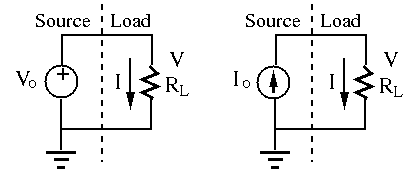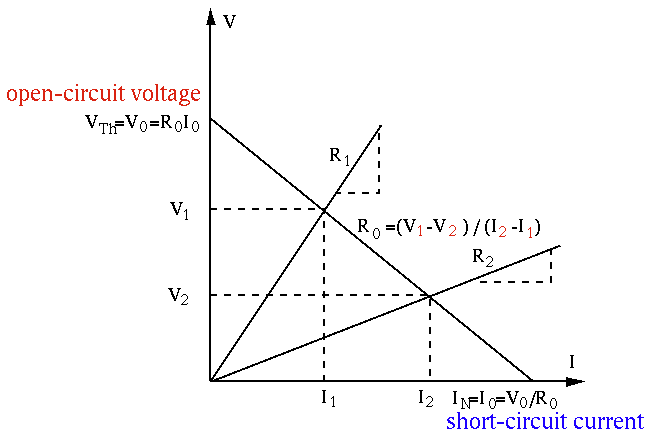Next: Source and Load Up: Chapter 1: Basic Quantities Previous: Kirchhoff's Laws
Ideal Energy Sources:
Consider the following ideal voltage source 






 independent
of the current through it
independent
of the current through it  . The ideal voltage source can
provide constant voltage to any number of resistors in parallel with
the source, independent of how much current they each draw.
. The ideal voltage source can
provide constant voltage to any number of resistors in parallel with
the source, independent of how much current they each draw.
 independent
of the voltage across it
independent
of the voltage across it  . The ideal current source can
provide constant current to any number of resistors in series with
the source.
. The ideal current source can
provide constant current to any number of resistors in series with
the source.

However, such ideal sources do not exist in reality, due to the following dilemmas:
 (short circuit), the load voltage
(short circuit), the load voltage
 ,
,
 (open circuit), the load current
(open circuit), the load current
 ,
,
Realistic voltage source:
In reality, all voltage sources (e.g., a battery or a voltage amplifier
circuit) can be more realistically modeled by an ideal voltage source 










 |
(101) |
 and
and  , we get:
, we get:
 |
(102) |

In the V-I plot, the function curve








The function curve 



For the output (load) voltage 



Only in the case of an ideal voltage source with 





 |
(103) |
 ), the output
voltage of a battery is zero (instead of the specified
), the output
voltage of a battery is zero (instead of the specified  ), as
the voltage drop across the nonzero internal resistance
), as
the voltage drop across the nonzero internal resistance  is the same
as
is the same
as  , i.e., the electric energy of the battery is consumed internally,
with no energy delivered to external circuit.
, i.e., the electric energy of the battery is consumed internally,
with no energy delivered to external circuit.
Realistic current source:
In reality, all current sources (e.g., a solar cell or a current amplifier
circuit) can be modeled by an ideal current source 








 |
(104) |
 and
and  , we get
, we get
 |
(105) |

In the V-I plot, the function curve








The function curve 




The slope of the first curve is the internal resistance 



For the output (load) current 



Only in the case of an ideal current source will





 |
(106) |
Energy Source Conversion
Any two circuits with the same voltage-current relation
(V-I characteristics) at the output port with 

Comparing the voltage-current relations of the two energy sources:
 ):
):
 |
(107) |
 :
:
 |
(108) |
 and
and
 , then the two sources have the same
V-I characteristics and are therefore equivalent to each other. We
also see that
, then the two sources have the same
V-I characteristics and are therefore equivalent to each other. We
also see that
 can be converted into a
non-ideal current source
can be converted into a
non-ideal current source
 ,
,
 can be converted into a
non-ideal voltage source
can be converted into a
non-ideal voltage source
 .
.

Both of the two energy sources above can be treated as either a voltage or a current source.
 and is therefore a good
voltage source as the voltage
and is therefore a good
voltage source as the voltage  received by the load is close to
the source voltage
received by the load is close to
the source voltage  , but a bad current source as the current
, but a bad current source as the current  received by the load is much lower than the source current
received by the load is much lower than the source current
 .
.
 and is therefore a bad
voltage source as the voltage
and is therefore a bad
voltage source as the voltage  received by the load is much lower
than the source voltage
received by the load is much lower
than the source voltage
 , but a good current source as the
current
, but a good current source as the
current  received by the load is close to the source current.
received by the load is close to the source current.
The Internal Resistance 
The internal resistance 
 |
(109) |
 and
and  are respectively the difference in voltage
and current between any two points along the line, which can be chosen
arbitrarily. The most convenient choice would be the intersections of the
straight line with the
are respectively the difference in voltage
and current between any two points along the line, which can be chosen
arbitrarily. The most convenient choice would be the intersections of the
straight line with the  and
and  axes:
axes:
 |
(110) |
 |
(111) |

While this method can be used to find the internal resistance 












Example 1:
A given voltage source of 









Example 2:
A given current source of 









Power Delivery/Absorption
 in a circuit is such that it
goes internally through a voltage source
in a circuit is such that it
goes internally through a voltage source  from its low potential
(-) to high (+), and externally through the rest of the circuit from
high to low, then the polarities of the voltage and the current are
consistent (both positive or negative depending on the assumed
polarity), and the source is delivering power
from its low potential
(-) to high (+), and externally through the rest of the circuit from
high to low, then the polarities of the voltage and the current are
consistent (both positive or negative depending on the assumed
polarity), and the source is delivering power  .
.
 will be negative, i.e., the voltage source is actually
receiving power. A typical example is the rechargeable battery in your
car that works in either of the two states.
will be negative, i.e., the voltage source is actually
receiving power. A typical example is the rechargeable battery in your
car that works in either of the two states.
 across a current
source is such that the head of the arrow of the current source is
at high potential (+) and the tail of the arrow is at low potential (-),
then the polarity of the voltage and the current is consistent, and
the current source is delivering power
across a current
source is such that the head of the arrow of the current source is
at high potential (+) and the tail of the arrow is at low potential (-),
then the polarity of the voltage and the current is consistent, and
the current source is delivering power  .
.
 will be negative, i.e., the current source is actually
receiving power.
will be negative, i.e., the current source is actually
receiving power.
Example 3:
The current in a circuit composed of an ideal voltage source 





Example 4:
In the circuit shown below, the ideal current source is 



The current source provides 




 is
is
 ,
,
 .
.

 .
.
(Homework) Redo the above with the polarity of 
 :
:
Comment: While various voltage sources such as batteries are common
in everyday life, current sources do not seem to be widely available. One
type of current source is solar-cell, which generates current proportional
to the intensity of the incoming light. Also, certain transistor circuits
are designed to output constant current. Moreover, as discussed above, any
voltage source can be converted into a current source. For example, a
current source with 



Example 5 (Homework)

A realistic voltage source (e.g., a battery) can be modeled as an ideal
voltage source 



 |
(112) |
 can be obtained as the ratio of the
open-circuit voltage
can be obtained as the ratio of the
open-circuit voltage  to the shirt-circuit current
to the shirt-circuit current  , which
can be measured by an ammeter:
, which
can be measured by an ammeter:
 |
(113) |
However, in reality, any voltmeter has an internal resistance 









Assume









Design a method to obtain the true source voltage 









Example 6 (Homework)
Usually the internal resistances of the voltmeter and ammeter are not
readily known (and the values may change depending on the scale used).
As another method to find 






Assume when the load resistor is






Answer:
 |
(114) |
 |
(115) |
 |
(116) |
 |
(117) |